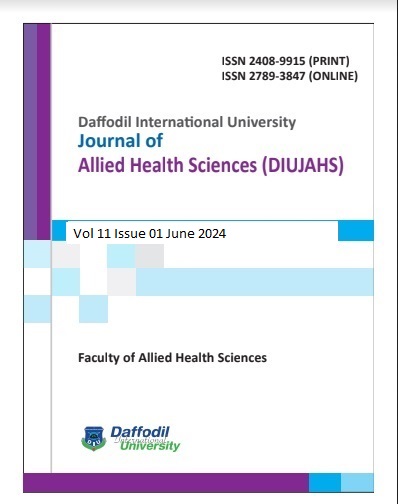Dengue Fever: A Persistent Public Health Challenge in Bangladesh
DOI:
https://doi.org/10.36481/diujahs.v11i1.hthcg565Keywords:
Dengue Fever, Vector Control, Urbanization, Mosquito Breeding. Public Awareness.Abstract
Dengue Fever is spreading rapidly, and more people are suffering from the disease in Bangladesh. This comes when the country faces large-scale disease expansion due to population growth, climate changes, urbanization, and ineffective measures in vector control. Currently, the DGHS Dengue Dashboard indicates approximately 170,000 cases in 2024 and more than 1000 deaths as reported (DGHS, 2024). Most cases are distributed in Dhaka and Chattogram. Most dengue occurrence is its peak in the monsoon season. The age group most affected is 20–40 years, though some cases are also observed in children. Alarmingly, the number of infected in 2023 was 321017, which is the highest in the last 7 years so far. This year the number is less than 2023, but dengue has not been curing. Therefore, there is a lack of sufficient research on dengue (DGHS, 2024). The Aedes aegypti mosquito spreads dengue fever, with cases peaking during mosquito outbreaks at certain times of the year. However, this year, the outbreak has become alarmingly widespread among urban and rural populations. This widespread has occurred for some reasons such as stagnant water bodies, lack of public awareness, ineffective mosquito control measures, rapid urbanization, poor waste management, climate changes leading to prolonged rainy seasons, and insufficient government-led vector control programs (Sharmin et al., 2015). The clinical presentation varies from mild febrile syndrome to serious clinical features such as severe dengue hemorrhagic fever and dengue shock syndrome, which are life- threatening and need emergency care. Reports from hospitals all over the country indicate excessive numbers of patients leading to diminished resources and increased deaths (Sharmin et al., 2015). As the situation stands, there is no specific antiviral medication that would assist in management so one is left with palliative care. Though a vaccine is there, it has many complications too (WHO, 2024). The dengue epidemic crisis draws attention to an integrated and multidisciplinary response as advocated by the government, health workers, and society. The focus in the long term however needs to be on the sustainable measures that include better urban design, development of more efficient drainage systems, and the initiation of community awareness programs (DGHS, 2024).

